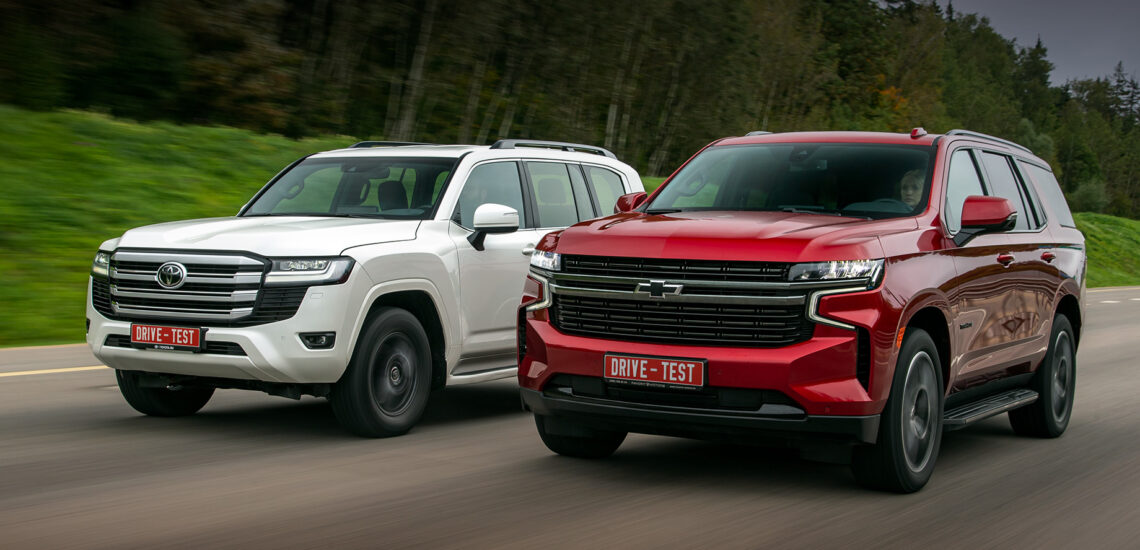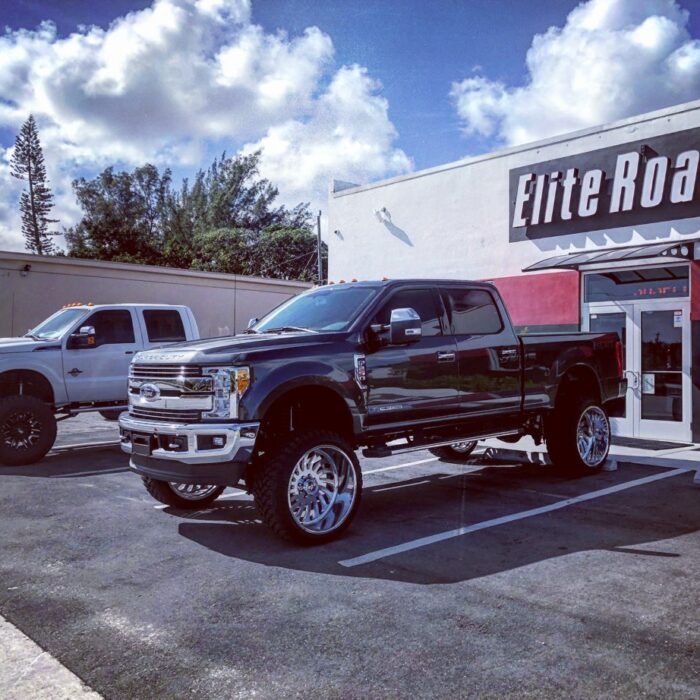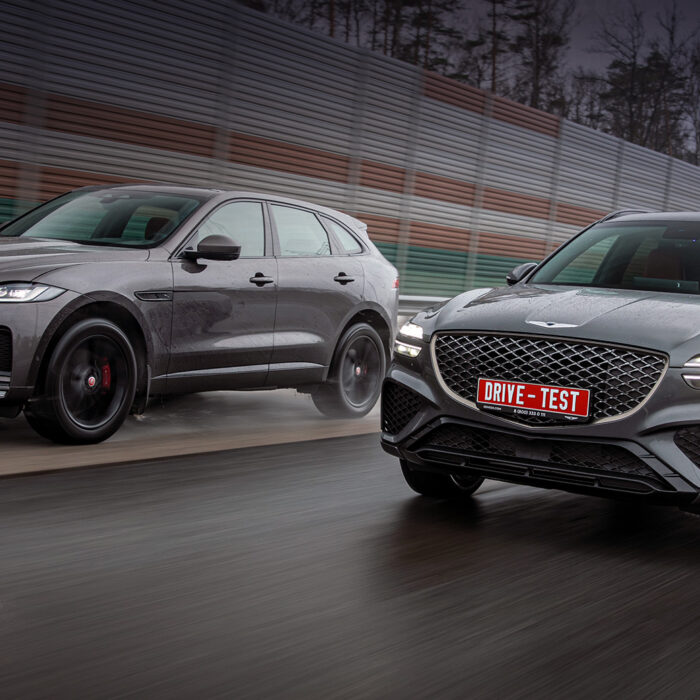Introduction to the framed Chevrolet Tahoe and Toyota Land Cruiser 300
Have you seen the faces of all previous Land Cruiser owners watching the 300`th? Kids never look at candies that way! The loyal audience had accepted the new — not that brutal — look, just as they weren’t surprised by the V8 ‘s absence. No one had ever questioned the Cruisers driving ability, although, they should have. However, Land Cruiser 300 not just kept all it`s off-road abilities, Toyota had improved the city and level ground driving. Chevrolet Tahoe has the same changes. The Tahoe is framed, just like Cruiser, but the difference is that Chevrolet has MacPherson strut independent suspension, while Toyota has independent double-wishbone front suspension.

Land Cruiser 300 is smiling with it`s air intake, which wraps the bottom of a funny radiator grille. Most external body panels are made of aluminum, beneath it there is a stronger frame and chassis GA-F with lowered gravity center.
This boy lost 440 pounds, but still kept its dimensions. Length has increased fr 1,5 sm, height digreased for 1.18 inches, width and wheelbase are the same. Only the height is reduced by 30 mm, but this didn’t affect the boarding process. I grab the handrail on the front pillar, carefully stand on the footboard so as not to get dirty, and I sit down more comfortably than in the 200 Series.
The steering wheel is less sloping and can be regulated on a longer shoulder than it used to be. The seat is lower now — legs are less bent. You depress the pedals rather than step on them. However, the seat is still high — even if you lower your seat to maximum, you’ll see, it’s a wide hood with its typical hollow in the middle. There are no questions about the driver’s seat itself, even on long trips. Although a distinct lateral support, a pillow extension and a vertical adjustment of the lumbar support would come in handy.

The steering wheel doesn’t heat up all over the rim, you probably won’t find the worst wood finish than Toyotas. Multimedia is a special case here. New widescreen display is only allowed in the Land Cruiser 70th Anniversary and GR Sport, while Comfort+ has an outdated system, which is quite slow thinker, low screen resolution, and the graphics came from the past. However, among advantages there are convenient touchscreen disposition, large font and fast Bluetooth connection with smartphones.
The Land Cruiser is impressive on the outside, but the Chevrolet Tahoe is, all in all, effective. Especially the RST sport edition with 22-inch wheels (Cruiser has 18 inches), off-road complectation Z71 with All Terrain tires, underbody protection, improved geometric passability and exposed front towing point.
The driver feels much more comfortable in Tahoe, rather than in Toyota. The seat is lower and better in keeping body form. It has more seat adjustment range, the cushion is longer, although there is no extender. The steering wheel is more upright and has no wood-ish inserts, which makes it more pleasant to touch, and the wide center armrest is better positioned. In general, only one thing prevents more relaxed sitting in Tahoe — the feet are more bent relative to the lower leg. An adjustable pedal assembly could solve the problem, but it’s absent here.
In addition to everything else, the display that is located between speedometer and tachometer is showing us four virtual watch faces, which is hard to read because of its small size and fuzzy image. Transmission control unit is located beneath the steering wheel, right next to where your right hand is supposed to be, which is quite convenient, but why do some of the buttons you have to press and the other half-pull? The central console buttons and the only one understeering switch take some time to get used to.
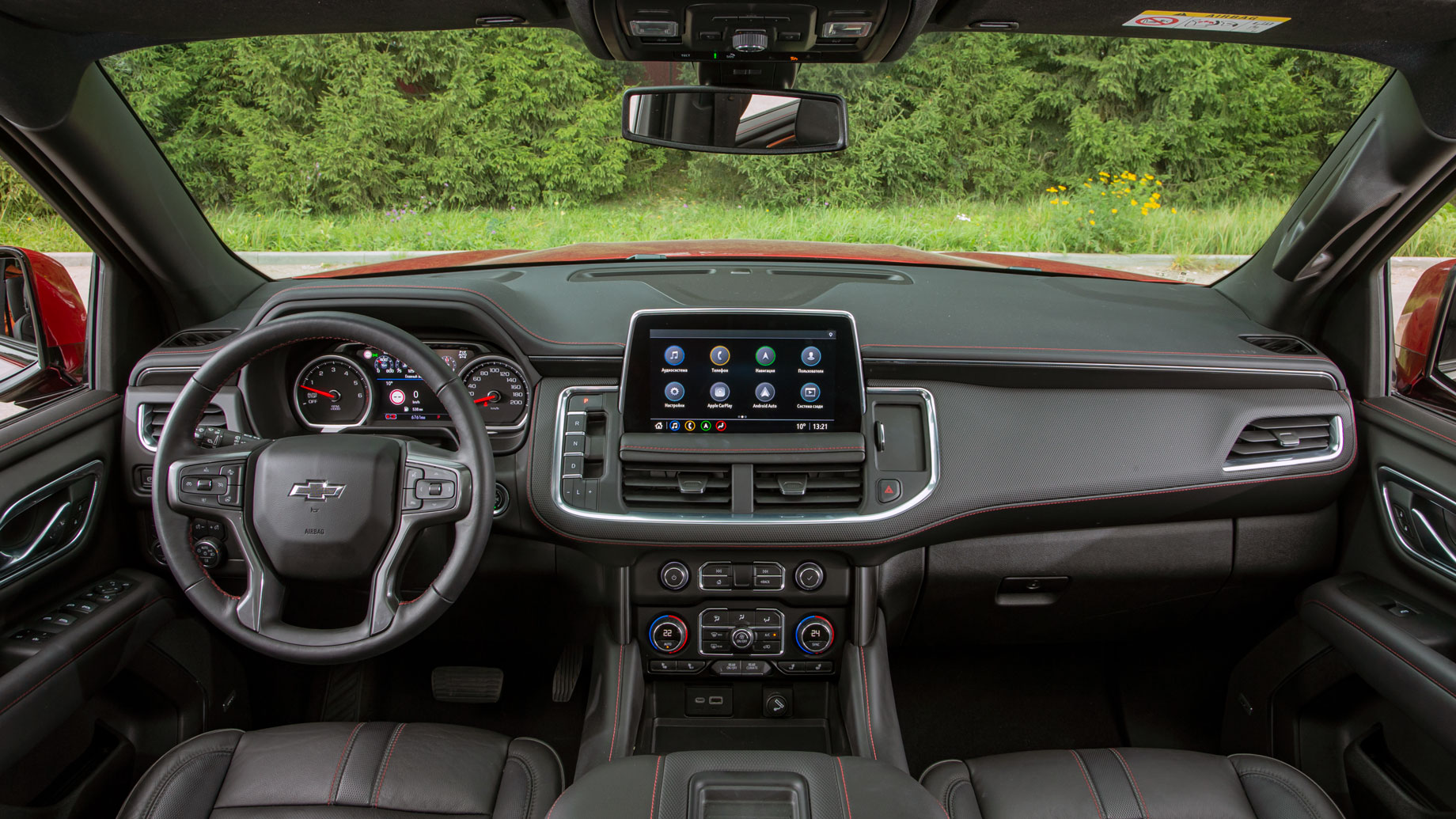
Tahoes multimedia is much better than Toyotas. Bigger ten inch touchscreen with higher resolution, faster reacts on touch, runs smoothly even when it manipulates with navigation map. Slower bluetooth connection with smartphones, but wired Android Auto is more stable. Chevrolet allows you to order, for a surcharge, an entertainment system for the back row passengers.
Even without this system Tahoe is much more entertaining for the back row passengers. There are larger rear door openings, the floor is lower, and the body falls to the ground on air springs if needed. Separated seats with soft cushions are moving in a longitudinal direction, and their stiff backs can be tilted to a fairly large angle. Geometry is better and the amount of free space is bigger in Chevy. Overhead space is smaller than in Toyota, but still enough. In front of my knees (my height is 5’9), the margin is twice as large as in Toyota — up to 5,12 inches. There is less space above my head in Tahoe, but still enough (3,15 inches vs 4,33).
If Tahoe would have a three-seat couch, you’d have to move it to reach the backseat. In this case it’s not necessary — separated seats allow you to move freely. The sitting geometry doesn’t ruin a pleasant experience, the middle seat can be adjusted so that there is enough space in front of the knees for everyone. In the back row, I sit down with a gap of up to 4,33 inches, a gap of 1,57 is above my head. For the passengers there are a few cup holders and USB-C connectors.
The Land Cruiser on the second row offers plenty of space, plus dual-zone climate control instead of the Tahoe’s single-zone. It would be nice to add comfort to the sofa: the stuffing under the skin is too dense, the pillow that doesn’t move in the longitudinal direction is closer to the floor than we would like it to be, and the back is flat, although it is adjustable in tilt angle. The $84,000 car also doesn’t have heated seats, though Chevrolet does have it by default. Indeed, even the base Cruiser for $ 72,000 doesn’t have heated front seats.

When starting, the car lifts its nose, abruptly jumping forward, and can accelerate from 0 to 100 km/ h just for 6.9 seconds with a combined fuel consumption of 8.9 liters per 100 km. It is 2 seconds faster than the previous model, which was achieved by compensating the two cylinders by the same amount of turbochargers, so the engine develops a power of 415 hp. and 650 Nm of torque.
There are faster and more powerful AWD-cars out there, but still, the 300 is one of the best. In the city jam even the Comfort mode is quite enough. Soft response to the gas and brake pedals, but is still fast and enough. On Normal settings, the axellerator responds even faster, and the Sport S setup could be enough — the CUV follows the gas pedal, as if on a rigid clutch. But still, it has an even more powerful Sport S+ mode, which you should ride on only for the experiment.
Even a ten-speed AGB doesn’t spoil the feeling of lightness from riding this car. Although, it tried. With alternating loads, the box often gets confused in gears, putting them in the wrong place. Downward transitions are accompanied by noticeable pauses, especially when it is necessary to skip several ranges. But the situation isn’t that critical and this is why — a powerful engine gets the job done.
When I start the Tahoe engine, I break into a smile — what a sound! Deep, seething at 2000-3000 rpm and brutally roaring closer to the red zone of the tachometer. Still, it’d be better to pull to match the roar… After accelerating by putting pedal to metal Racelogic fixes 8.6 seconds when picking up to a hundred. This is six tenths slower than the passport value, and the difference with Toyota is completely huge. The Land Cruiser is blown away like a fluff, and the Chevrolet accelerates as if under the lash.

Tahoe becomes more responsive, faster, and more opportunities for dynamic overtaking on country roads as soon as the crankshaft accelerates to 5000 rpm and above. Although, at 120 km/h and higher — Chevrolet is getting a little tired. Land Cruiser is, on the other hand, feeling good at 150 km/h and above.
The feeling of boredom in the Tahoe is reinforced by the damped accelerator, which is very sluggish in the first third of the stroke. You can diversify it with the Sport mode and higher engine speeds, but even then Tahoe doesn’t reach the Land Cruisers level. The gearbox has the same problems as Toyotas transmission, but works even slower — it can easily be lost in its ten-speed gearbox and takes time to think if it wants to engage low gear. The gear shift also changes roughly, although smoother than the Cruiser’s one.
At least, the Chevrolet chassis is more refined. There are fewer vibrations of unsprung masses, there are no characteristic kicks from a beam axle, energy intensity has increased. The stroke feels good even on deep pits, with a sharp edge. I only wish the body not to throw from side to side on bad sections of the road.
Tahoes control has visible changes — it’s a car, not just a truck, as it used to be. Chevrolet is quite responsive, willingly shifting on a winding road and holding tenaciously in a high-speed arc, regardless of the quality of the roadway. Body roll is quite big, but it can be avoided with the sport mode, which compresses adaptive dampers and air springs. Alas, the edgy steering wheel is also pointlessly heavy. In normal modes, zero information is assigned, but by drooping, it can still bypass the start of the demolition. By the way, it will quickly be stopped by the stabilization system that can be switched off up to 19.8 miles/h.
The Toyota is interesting for fast driving: the reaction to the steering wheel is a little edgier, the speed in turns is higher, and the drift phase is quickly replaced by the slip of four wheels. Even the cruiser’s insurance electronics is set up more liberally, and if desired, it can be completely deactivated. However, the Cruiser falls on its side more strongly, its longitudinal oscillations are more expressed. There is little hope for a suspension sports mode — it spoils the ride comfort more than makes the car more assembled.
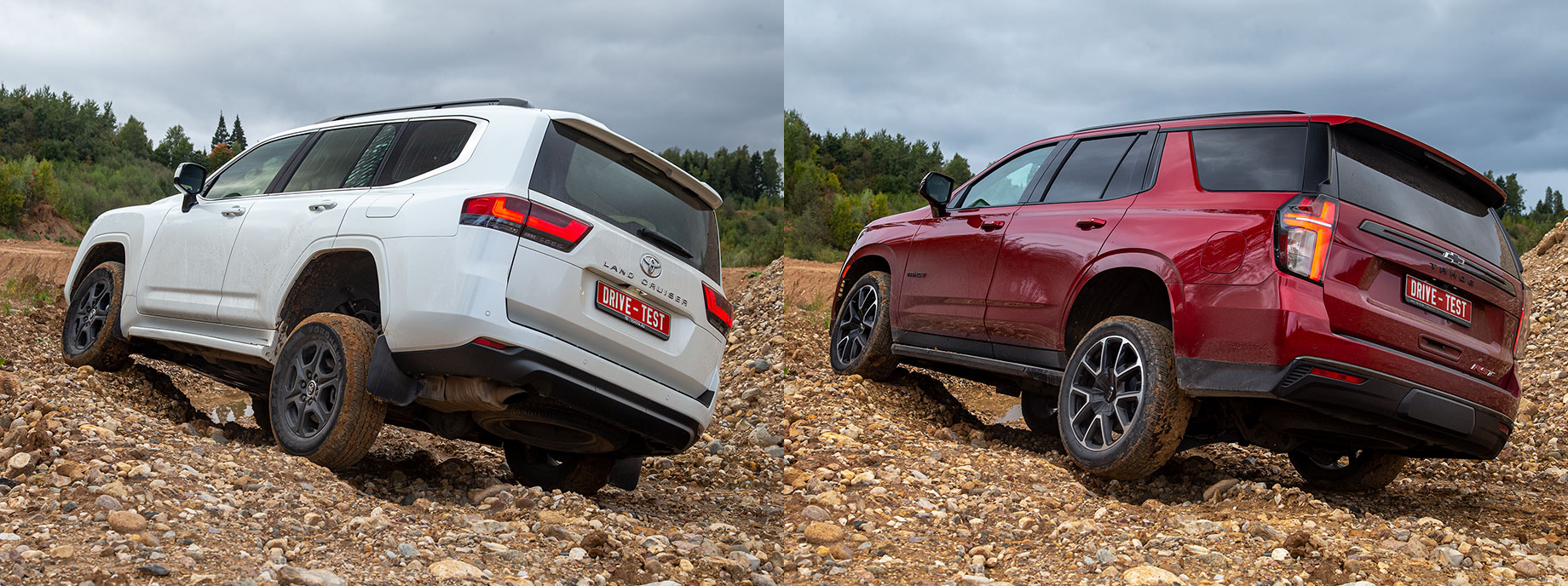
There are enough problems with suspension comfort. Land Cruiser is, mostly, rougher, especially on medium and large potholes. On a flat road, the Cruiser 300 constantly finds a reason for jerks. The rear suspension is twitching in its special way — on 9.3-12.4 miles/h and faster at artificial bumps it throws up the backseat passengers. At least, the vehicle interior is noticeably quieter, thanks to double side windows and better soundproofing of the wheel arches.
You’ll see all these improvements on off-road. On the bumps, the Land Cruiser raced so that the Tahoe was lost in the dust. No rule violations, no bumps in the suspension — exemplary behavior on rough terrain. If Toyota can keep 37-43 miles/h without straining, then for the Chevy even 25 miles/h is too much. Suspension knocks, clashes occur both during compression and rebound. Not to mention the front bumper lip and rear control arms…
However, Tahoes air suspension not only maintains the clearance and deflates, but raises the body by 50 mm, if necessary. We drove on sand, muddy mud, forced climbs with a wet, loose coating, but the car wasn’t planted anywhere. Those obstacles that they couldn’t take from their place were overcome at a low speed. And the lowering row was most needed when we pulled out the Land Cruiser, planted on the belly.

On the Toyota, we went through the dirt. We had been plowing the treacherous area for a long time, until we naturally landed on a high, hard bend under soft clay. However, don’t let this preliminary result trick you — a real SUV here is the Land Cruiser 300. It has bigger clearance, better geometric passability, and smarter electronics. Instead of an endurance front electromagnetic clutch — permanent four-wheel drive. All three differentials can be forcibly blocked, when Tahoes rear block is controlled by electronics only.
The gravity center closer to the ground, with the tuned suspension, made the Land Cruisers step a little more confident. Stunning biturbo petrol engine gives Toyota a whole new level of dynamics. That very framed SUV, that feels more comfortable on the off-road, then on a hard surface. Still, with the excellent sound insulation, it would be great to make the asphalt riding smoother. Land Cruiser 300 will spend most of its life on city riding after all.
The Tahoe seems to be more complete than the Toyota. Still, the Cruiser’s calm atmospheric V8 engine combines well with a balanced driving character, and a high level of comfort — with a spacious and cozy interior. Great for a family car! However, the impression is spoiled by an inexpensive interior trim and truncated equipment list compared to the overseas Tahoe.
This is a translation. You can read the original here: https://www.drive.ru/test-drive/chevrolet/toyota/6169a811c083e6637ae3a79e.html

